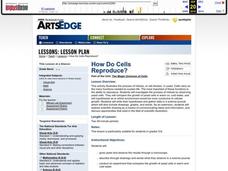Curated OER
Spray Bottle Paint Mural
Sometimes all you need is a quick and easy outdoor art project. Perfect for the end of the school year, this mural project allows kids to make a mess while creating art. They use spray bottles full of paint to "spray" paint a large sheet...
Curated OER
How Do Cells Reproduce?
Beginning biologists prepare a sugar solution for yeast cells to live in, and divide it into two different jars. Samples from each jar are viewed with a microscope, and then one jar is placed in a warm environment and the other a cold...
Curated OER
Acrylic Painting Value Scales
So, you're about to get out the acrylics and you need a way to introduce hue, shades, and value scale when painting. Lucky for you this instructional activity provides instruction and two scales for your class to use for practice!
Curated OER
The Sun's Energy
Sixth graders examine how the sun's energy arrives as light with a range of wavelengths. They discuss the characteristics of light, examine the color of light using a spectroscope, and conduct an experiment using water and thermometers....
American Chemical Society
Using Chemical Change to Identify an Unknown
If you have taught the first lesson in this mini unit, learners already know that cabbage juice and vinegar cause chemical changes in some materials. Now, they get a chance to use them to compare the liquids' reactions to five known and...
Texas State Energy Conservation Office
Investigation: Chemical Models
Science teams make models of four different hydrocarbon compounds that we commonly use for fuel. Then they demonstrate chemical reactions that result when energy is produced. This can be used as an enrichment when your class is studying...
Captain Planet Foundation
Sorting Out Soils
Sift through soil and learn about why it's important for organic processes. After discussing what makes up soil, such as the living organisms and what types of soil have more nutrients, kids sample layers of mulch and deeper soil to...
Baylor College
Tools of Magnification
Life science learners need to be able to use a microscope. With this comprehensive resource, they first experience how lenses and magnification work, and then get familiar with using a compound microscope. Tremendous background...
Chicago Botanic Garden
Historical Climate Cycles
What better way to make predictions about future weather and climate patterns than with actual climate data from the past? Young climatologists analyze data from 400,000 to 10,000 years ago to determine if climate has changed over time....
Curated OER
Understanding Waves
Students perform 3 hands-on activities to help them explain the terms "crest" and "trough" as related to sound, water, and light waves. All three waves types have troughs and crests. The activities use toys to demonstrate the properties...
Curated OER
Virus Tracker
Sixth graders will simulate the spread of a virus such as HIV through a population by "sharing" (but not drinking) the water in a plastic cup with several classmates. Although invisible, the water in a few of the cups will already be...
Curated OER
Rainbow in a Baggie
Students create rainbows in a bag. In this art activity, students create rainbows using cornstarch, water, sugar and food coloring.
Curated OER
Hot and Cold Colors
Young scholars examine how temperature effects changes in materials. In this physical science lesson, students use food coloring and cups of water of varying temperatures to observe the effects temperature has on matter. Young scholars...
Curated OER
Diffusion of Molecules
Students conduct a series of experiments to observe factors that impact molecular movement. In this molecular chemistry lesson, students drop food coloring in water with different properties (hot, with ice, with alcohol) and observe how...
Curated OER
Heat Loss and Cool Gains
Fifth graders predict what happens when cold and hot water are mixed together. In this physics lesson, 5th graders discuss how heat transfer takes place. They record temperature readings and compare it with their prediction.
Curated OER
Indicators For Acids and Bases
Fourth graders compare the color of cabbage water when acids and bases are mixed in. In this acids and bases lesson plan, 4th graders use cabbage water and mix in acids and bases that the teacher prepares before hand. They observe the...
Curated OER
Underwater Hide and Seek
Students explain why color patterns that are easy to see above water may be difficult to detect under water and experience the problems predators face when searching for camouflaged prey.
Curated OER
Groundwater Pollution Lab
In this groundwater pollution instructional activity, students use a piece of bread to represent the earth, food coloring to represent contaminants in the ground and water to simulate the movement of pollutants with water through the...
Curated OER
Mix It Up : Colors
Fifth graders make predictions of the resulting colors when colors are mixed. In this colors lesson, 5th graders discuss vocabulary related to mixing colors. Students are asked to paint a picture of five colors from two colors of...
Curated OER
Acid Rain Environment Pollution
Students combine different materials to create chemical reactions. In this chemical reaction lesson plan, students will combine different materials to create chemical reactions and define these results as acids or bases. They will also...
Curated OER
Compared to What? Comparing the Density of Different Liquids
Students work in groups to compare the density of different liquids. For this density lesson, students use cooking oil, liquid detergent and water to measure density. Students record their results and check the accuracy of their...
Curated OER
Mixing Colors
Students understand why we see various colors. In this mixing colors lesson, students experiment with different food coloring to explore how colors are made. Students record on a data sheet the colors they see.
Curated OER
How Low Can You Go?
Fourth graders experience measuring temperatures after determining, by touch, whether water is hot or cold. They use a thermometers to measure the temperature of water in three cups of water. Using a vertical number line, they write the...
Curated OER
Density Lessons and the Oil Spill
Teachers can use the oil spill cleanup efforts as a springboard to discussions and activities related to density!

























